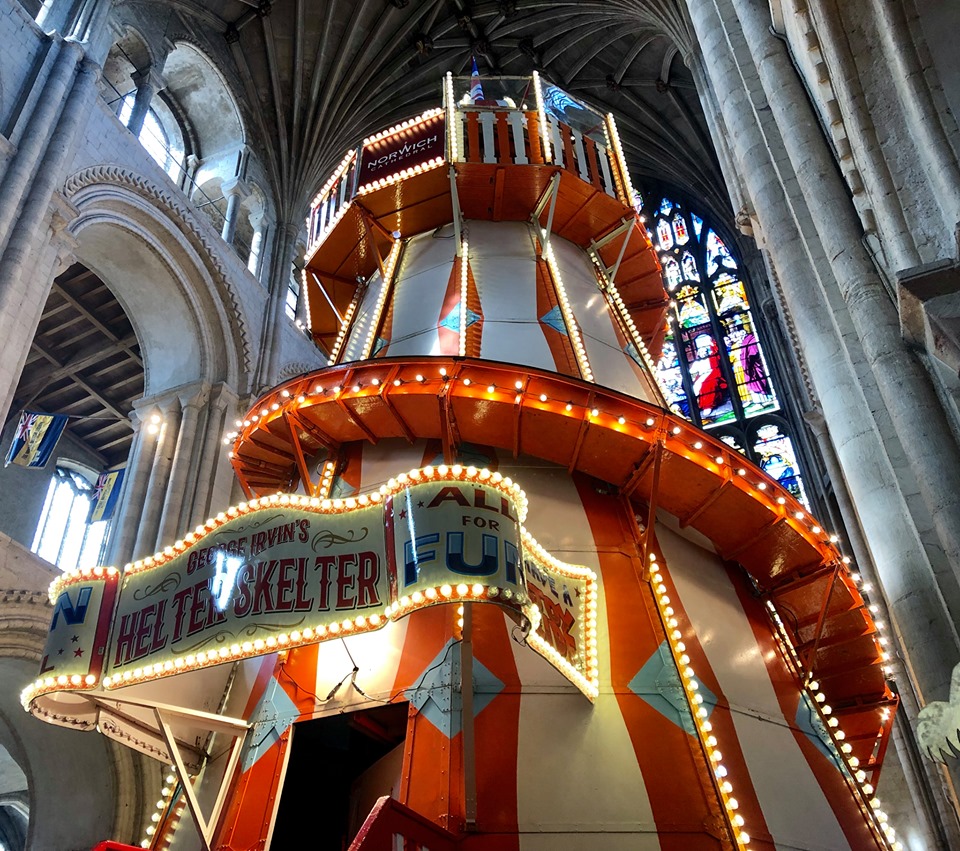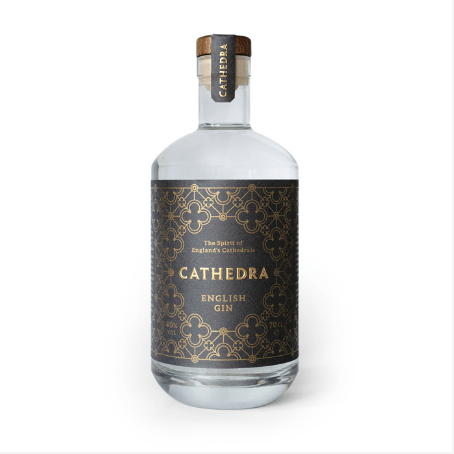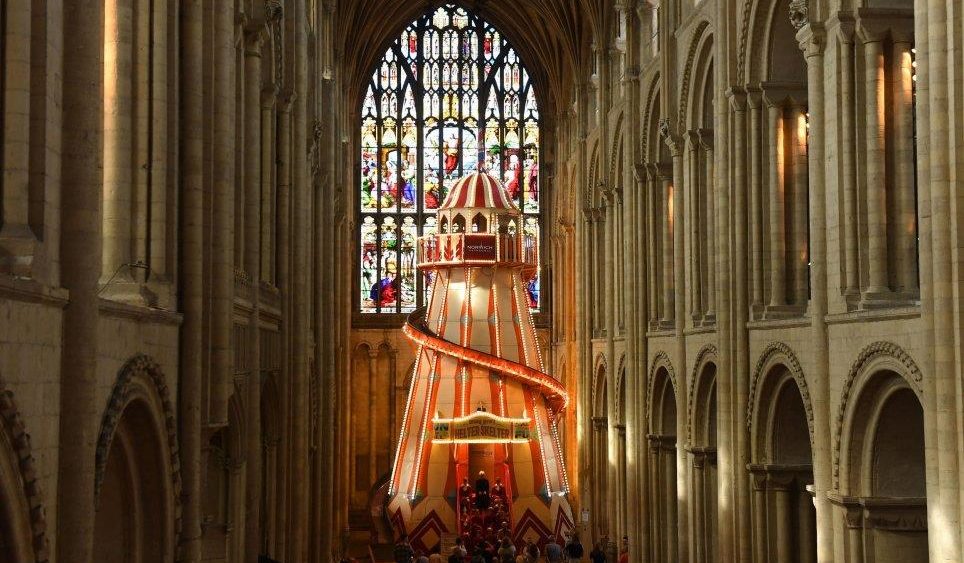UK cathedrals become amusement parks to attract visitors
Slides, mini golf and gin – drawcard or distraction?
A 15-metre amusement slide has been built in the middle of Norwich Cathedral in Norfolk, in the east of England.
The “helter skelter” ride is part of the “Seeing It Differently” project, an effort from the cathedral to encourage visitors to see the Romanesque structure – considered one of the finest in Europe – from new angles. The slide will be in the cathedral for two weeks. 
“Could the playful presence of a helter skelter help to open up conversations about the building, help open up conversations about God?” – Canon Andy Bryant, Norwich Cathedral
“Could the playful presence of a helter skelter help to open up conversations about the building, help open up conversations about God? This unexpected presence in the Cathedral would act as a draw. Climbing to its top, the visitor will literally see the Cathedral differently. They will also come closer to the roof bosses [intricately carved roof decoration] and to the story they tell, the story of Salvation,” wrote the Canon Andy Bryant, from Norwich Cathedral on the cathedral’s blog last week.
The cathedral has come under fire for the move, with vocal blogger and commentator Gavin Ashenden – missionary bishop for the Christian Episcopal Church and former chaplain to the Queen – arguing the helter skelter’s presence in Norwich Cathedral is part of a broader trend for UK cathedrals to sell out in order to get people into the building.
“In every generation,” Ashenden writes, “the Church faces a live or die challenge: Convert or be converted.
“Either act as an agency for people to encounter the Living God and be forgiven, turned and transformed; or fit into the unforgiving contours of a society that is driven by other forces, other appetites, and smear over their agenda a patina of spirituality that confers a thin covering of political and cultural legitimacy.”
Norwich Cathedral isn’t the only cathedral to try something different to attract visitors.
Rochester Cathedral, just outside London, has installed a mini golf course in the cathedral for the month of August. Rachel Phillips, Canon for Mission and Growth at Rochester Cathedral said that the golf course aimed to attract people into the cathedral who might not visit a church otherwise. The nine-hole course has a bridge theme, encouraging people to “reflect on the bridges that need to be built in their own lives and in our world today,” said Phillips.

Rochester Cathedral’s mini golf course Rochester Cathedral
In 2016, Gloucester Cathedral transformed its 1300-year-old building into a skate park for a skate festival hosted by Christian Skaters UK, as a way of attracting young people.
“The chairs have been cleared from the nave of the cathedral, one of Britain’s oldest churches, and replaced by ramps, quarter pipes and boxes on which youngsters can practice their skateboard and scooter tricks,” said a writer for Skater-blog Ride UK.
“Blackburn is not a tourism centre, it is not a rich part of the world, and we need to reach out to markets beyond our town and region to be sustainable long term.” – Dean of Blackburn Cathedral, Peter Howell Jones
In Blackburn, Lancashire (northwest of Manchester), Blackburn Cathedral has its own brand of gin – Cathedra – to generate revenue for the cathedral’s ministry.
“Blackburn is not a tourism centre, it is not a rich part of the world, and we need to reach out to markets beyond our town and region to be sustainable long term. Gin is on trend; it is a developing market, and there is a long history of monastic communities brewing mead, wines and beers,” the Dean of Blackburn, Peter Howell Jones told Christian Today last year.
Cathedrals in the UK are in “crisis”, struggling to fund themselves and the soaring costs of maintaining the ancient buildings. In a 2018 conference on cathedrals called “Sacred Space: Common Ground”, the Master of Emmanuel College, Cambridge, Dame Fiona Reynolds (who chairs the Cathedrals Fabric Commission for England) told attendees, “Although we all work together to avoid the line that ‘Cathedrals are under threat’… there is still a crisis,” she said. “There’s a constant, rolling, and growing need for money in cathedrals … We have a huge problem that each sticking plaster of money is helpful but doesn’t deal with the underlying issue … Current funding arrangements are, frankly, not secure enough,” as reported by Church Times.
“Cathedrals exist so that people can meet Jesus.” – Kanishka Raffel, Dean of Sydney’s St Andrew’s Cathedral
Frank Nelson, Dean of Adelaide’s St Peter’s Cathedral says cathedrals “are always looking for ways to attract people into their ‘sacred space’.”
“In long ago days cathedrals were often the town halls, the market places, the gathering places for the community – they would not have had pews or chairs so very flexible,” Nelson told Eternity.
St Peter’s Cathedral attracts about 40,000 tourists a year, and Nelson says they do a lot to entice those who have never been inside to come and have a look, mainly religious concerts.
But slides, putt putt, skate parks and gin are going too far, argues Gavin Ashenden. They are a distraction from those who might actually want to seek God.

Blackburn Cathedral has created a gin brand to help fund ministry. Blackburn Cathedral
“The Church has the difficult business of conveying the awe, majesty and sheer danger of God while at the same time offering the safety, the healing, the forgiveness and the mercy of Christ …
“One of the characteristics of our astonishing Norman cathedrals is the way in which the architecture does just that. It lifts our minds and our hearts to the intimation of majesty grandeur, awe, immensity and by the difference in scale, our own insignificance by contrast. And at the same time offers us the presence of Christ as Lord and Saviour, who asks to be invited into the depths of our heart to forgive, heal and recreate in an act of the most profound metaphysical intimacy.”
“But for such a place, steeped in mystery and marvel to buy in to sensory pleasure and distraction, is to poison the very medicine it offers the human soul. It cracks the exquisite mirror it holds up before the presence of God; it drowns out the still, small voice, that Elijah encountered and adored.”
Dean of Sydney’s Anglican St Andrew’s Cathedral, Kanishka Raffel, says installing “recreational equipment” in English cathedrals “reveals a serious misunderstanding of the role of cathedrals”.
“Cathedrals exist so that people can meet Jesus,” Raffel told Eternity.
St Andrew’s Cathedral hosts about 150 visitors a day, and Raffel says they are deliberate in how they welcome them.
“Research shows that even non-religious people are drawn to cathedrals out of historic and cultural interest. This being the case, we try very hard at St Andrew’s to make sure that whatever has brought someone to our building, once they get here they have every opportunity to find out the reason we’re here, and to hear something of the Lord whom we serve.
“So, I suppose, [the English cathedrals here are making an] effort to give people another reason for coming – but I think it’s misguided. It feels too much like ‘bait and switch’ to me. At worst, it fundamentally misconceives what a cathedral is for.”
Email This Story
Why not send this to a friend?


